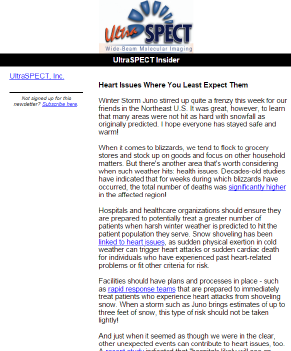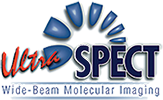 Heart Issues Where You Least Expect Them
Heart Issues Where You Least Expect Them
Winter Storm Juno stirred up quite a frenzy this week for our friends in the Northeast U.S. It was great, however, to learn that many areas were not hit as hard with snowfall as originally predicted. I hope everyone has stayed safe and warm!
When it comes to blizzards, we tend to flock to grocery stores and stock up on goods and focus on other household matters. But there's another area that's worth considering when such weather hits: health issues. Decades-old studies have indicated that for weeks during which blizzards have occurred, the total number of deaths was significantly higher in the affected region!
Hospitals and healthcare organizations should ensure they are prepared to potentially treat a greater number of patients when harsh winter weather is predicted to hit the patient population they serve. Snow shoveling has been linked to heart issues, as sudden physical exertion in cold weather can trigger heart attacks or sudden cardiac death for individuals who have experienced past heart-related problems or fit other criteria for risk.
Facilities should have plans and processes in place - such as rapid response teams that are prepared to immediately treat patients who experience heart attacks from shoveling snow. When a storm such as Juno brings estimates of up to three feet of snow, this type of risk should not be taken lightly!
And just when it seemed as though we were in the clear, other unexpected events can contribute to health issues, too. A recent study indicated that "hospitals likely will see in uptick in heart failure admissions after Super Bowl Sunday." It's in cardiologists' best interests to educate their at-risk patients ahead of the Super Bowl and similar annual celebrations, from Christmas to Independence Day, to minimize their risk. Beyond this, hospitals must be prepared for potentially increased heart failure admissions in the days following Super Bowl Sunday.
Keeping health top of mind can be unexpectedly life-saving during particular times and events - and it is the responsibility of patients and providers to ensure that such heart risks are minimized and prepared for.
Here's to a safer, healthier 2015 for all!
Regards,
Yossi
Q&A with Yossi Srour - DOTmed News
The health care industry has increasingly sharpened its focus on radiation monitoring, and that can only mean good things for patients receiving dose. That priority, coupled with the issue of implementing data into cross-platform EHRS and PACS, make this an especially interesting time to be in health care. DOTMed News had an opportunity to explore these issues with Yossi Srour, the president of UltraSPECT and a pioneer in the low-dose movement.
DOTmed News: Your company offers solutions for imaging with less radiation. Where did your interest in dose reduction originate?
Yossi Srour: My interest in dose reduction started in early 2008 when we first approached the FDA with our low-dose imaging product. For the 510(k) approval by the FDA, we presented equivalency of general full-dose images with half-dose UltraSPECT images. In April 2008, UltraSPECT was the only FDA-510(k) cleared product for low-dose imaging. The regulatory approach was to show equivalency between half-dose imaging using our proprietary Wide-Beam Reconstruction (WBR™) technology and full-time imaging using Filtered back projection (FBP) / Ordered Subset Expectation Maximum (OSEM). In this approach, UltraSPECT customers can reduce the radiopharmaceutical injected dose without compromising image quality. This is safer imaging, lowering the radiation exposure to patients, technologist and physicians. The other benefit is securing the radiopharmaceutical supply continuity by relying on a lower dose.
Many benefits, though the market response to our approved low-dose product in mid-2008 was "it is too early to the US market; maybe it is appropriate for the European market," It was in the following year, in mid-2009, when the U.S. market awareness of radiation risks was increased dramatically, though the circumstances were unfortunate. This was when two children in California received significantly more CT dose than they should have.
Following this event we have seen the much needed low-dose movement progress, though still a bit slowly, or at least more slowly than I would like to see. I was very interested in the American Society of Nuclear Cardiology (ASNC) outline methods for Minimizing Radiation Exposure in Patients which was published for the public review in June 2010. Also, the Image Wisely and Image Gently initiatives were gaining visibility as they pushed the demand for low-dose imaging, though mainly in CT. It took years, till January 1st 2014, to make ASNC low dose guidelines official. And now, although the ASNC guidelines have been effective for a year, the adaptation by NM labs is going very slow and the statistic shows only single digit percentage of adoption.
Read the full article at DOTmed News here.

